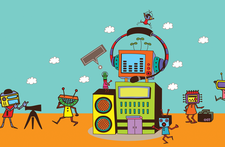Recording desktop activity
For the Record

We look at several tools, ranging from very simple to more complex – that can help you record various desktop activities.
Recording your desktop can serve many purposes: It can be a way of permanently recording a complicated procedure; it can prove that a student has completed an assignment, as the man page for the script command suggests; or it can enhance documentation, provide animated how-tos, and even assist with automatic testing, depending on the tools you choose.
The tools described in this article operate on several levels. At the simplest level, commands like script, ttyrec, and shelr serve as more permanent alternatives to a shell's history. By contrast, scrot takes stills, cnee records not so much visual events as the technical information behind them, and recordmydesktop produces movies made from desktop events. You could accurately say that recording tools are available for every purpose and level of users.
script
The script command writes a record of all actions within a shell (Figure 1). It is not much different from viewing a shell's history, except that it writes to file and is stored permanently. Script is one of several dozen commands installed in distributions as part of the linux-utils package.
[...]
Buy this article as PDF
(incl. VAT)
